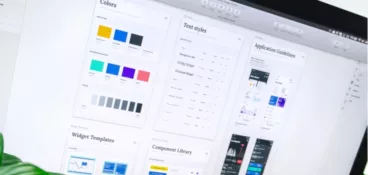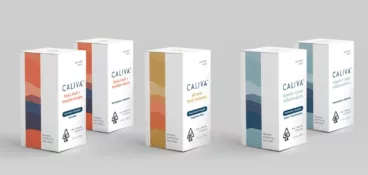Looking at the amount of digital content we consume daily, you might think that the print industry is counting its final days. But the recent statistic from Gitnux, actually shows a different trend. Based on their research, the printing industry is expecting a compound annual growth of 4.64% from 2021 to 2026.
So instead of waving its goodbyes, we can still expect to see a lot of print ads, brochures, and booklets coming our way.
To help you manage an otherwise manual and time consuming artwork approval process, we’ve created a comprehensive guide with everything you need to know about artwork management. Plus, how to optimize the process for your needs.
The fast way to get approval on artwork
Manage your artwork efficiently by getting clear and collaborative comments right on top.
Understanding the concept of artwork management
The artwork management process is about simplifying review rounds, getting faster approvals, and sending artwork to print in the most efficient way possible. Since the artwork creation and publication processes take a lot of stakeholders and review rounds, it’s important to create as efficient a design review process as possible.
Making sure that everyone – from copywriters, to artwork designers, to print studios – get the final and best version of the artwork is a hell of a ride. The process requires an exceptional eye for detail and great organization skills.
Without these two elements, you can easily end up with 500 new brochures with the wrong alignment, or an image that doesn’t really fit the page. And that’s where artwork management software comes in!
The rising need for artwork management software
As companies grow so does their content production, including both digital and print.
Whether you need to print travel brochures, flyers, or out of home ads, you need to produce print content with 100% accurate information.
But with so many tasks on your plate, it can be easy to miss important details. That’s why so many companies are turning to artwork management tools for help.
With a specialized artwork management platform, you can easily get your artwork from the production process to print fast and without errors. This software can also bring all your designers, copywriters, artwork designers, and print specialists together in one platform – which is a life-saver when the deadline is looming!
This helps everyone stay on the same page, avoid misunderstandings, and move the artwork through multiple review steps faster.
Real-life scenarios: benefits of automated artwork approval management
In short, artwork and design approval software automates a lot of the artwork approval process and reduces potential errors.
Here are some benefits of automating your artwork approval management:
- Bring all your stakeholders together in one platform for easier alignment
- Avoid time-consuming and inconvenient review rounds through email
- Always deliver on-brand content thanks to thorough review processes
- Make sure that the final version goes to print without confusion
- Save money by always being sure that the right version of the artwork went to print
The artwork approval process: a closer look
The artwork approval process can be riddled with complexities and potential pitfalls, making it a critical stage in any creative project. From miscommunications to subjective interpretations, various factors can lead to errors, delays, or even compliance violations.
One of the main challenges lies in the subjective nature of each artwork, where different stakeholders may have different expectations and interpretations. This can cause a long back-and-forth exchange of feedback and revisions, leading to project delays and frustration.
Another potential risk that your team should avoid at all costs is the compliance violation. This refers to using copyrighted material without permission or failing to follow brand guidelines.
By centralizing communication and streamlining collaboration in your artwork approval software, you and your teammates will be able to efficiently share, review, and comment on artwork to resolve potential issues.
Specialized business communication software will facilitate clear communication between stakeholders and help you make sure that all feedback is consolidated and properly addressed.
Artwork approval software solutions also incorporate features like version control, real-time notifications, and automated compliance checks. By catching mistakes early on and highlighting potential compliance violations, artwork approval software minimizes the risk of costly errors and ensures that final artworks align with brand standards and legal requirements.
Picking the right artwork management solution
When choosing the right artwork approval software, several key factors should be considered to ensure it meets your specific needs and effectively supports your workflow.
Here are some aspects to look for:
- Ease of use – The software should have a user-friendly interface and intuitive navigation, allowing all stakeholders, including non-technical users, to easily navigate and understand the approval process.
- Collaboration features – Look for features that facilitate efficient collaboration, such as the ability to leave comments, track changes, and annotate directly on the artwork. Real-time collaboration and notifications can enhance communication and streamline the review process.
- Version control – The software should offer robust version control capabilities, enabling you to track changes and easily refer back to previous versions of the artwork.
- Customization options – Consider whether the software allows for customization to match your specific workflow and branding requirements.
- Integration capabilities – Determine if the software integrates with other tools and software that are critical to your workflow.
- Compliance checks – Look for software that includes automated compliance checks to identify potential violations, like copyright infringements or deviations from brand guidelines.
- Security and access control – Assess the security measures provided by the software to protect your artwork and sensitive information.
- Reporting and analytics – Consider whether the software provides reporting and analytics capabilities to track metrics such as approval timeframes, reviewer feedback, and overall process efficiency.
- Customer support and training – Evaluate the level of customer support and training provided by the software provider.
Navigating the marketplace of artwork workflow systems
Navigating the marketplace of artwork workflow systems can be a daunting task due to its crowded nature and the numerous vendors offering their solutions. With a wide range of options available, it’s crucial to carefully assess the features and capabilities of different systems to find the one that best suits your specific needs.
Here are several factors to consider when comparing artwork workflow systems:
- Core functionalities
- Scalability and flexibility
- User experience and interface
- Pricing
- The quality of customer support
Core functionalities
First, evaluate the software’s core functionalities including, artwork submission, review and approval processes, collaboration tools, and integration capabilities with other software or tools essential to your workflow. Make sure that the system aligns with your existing processes and can effectively streamline your artwork approvals.
Scalability and flexibility
Second, consider the scalability and flexibility of the tool. As your organization grows or your artwork approval management needs evolve, the system should be able to accommodate expanding workflows and adapt to changing requirements. Look for systems that offer customization options and scalability features, allowing you to tailor the system to your unique needs.
User experience and interface
Third, assess the user experience and interface of the system. It should be intuitive, user-friendly, and accessible to all stakeholders involved in the artwork workflow. A visually appealing and easy-to-navigate interface contributes to efficient collaboration and smoother operations.
Pricing
Additionally, take into account factors such as cost, security features, customer support, and vendor reputation. Determine the pricing structure of the system, whether it is subscription-based, requires a one-time purchase, or has additional fees for specific functionalities. Consider the security measures implemented by the vendor to safeguard your artwork and data.
Customer support
Furthermore, explore the customer support offered by the vendor, including response times, available channels, and resources for troubleshooting or training. Research the vendor’s reputation in the industry, read reviews, and seek recommendations to gain insights into their track record and customer satisfaction.
Calculating the ROI of an artwork approval solution
Implementing an artwork approval solution helps your team streamline workflows, reduce delays, and improve collaboration. But before you go running for your next investment, it’s crucial to evaluate the return on investment (ROI) it can provide.
Here are a few factors to consider when calculating ROI of your artwork approval solution:
- Faster approval process
- Less errors and reworks
- Enhanced collaboration and communication
Faster approval process
By automating and digitizing the approval process, organizations can eliminate the need for manual tasks, such as printing and shipping physical copies of artwork for review. This leads to faster turnaround times and helps you move projects forward swiftly, allowing you to save time and improve overall productivity.
Less errors and reworks
An artwork approval solution provides a centralized platform for stakeholders to collaborate, ensuring that all feedback and revisions are tracked and implemented accurately. This significantly reduces the chances of miscommunication, misunderstandings, and costly mistakes.
Avoiding rework not only saves time but also minimizes expenses associated with redoing artwork or materials. Plus, making sure that everyone makes less mistakes helps you increase productivity among all team members.
Enhanced collaboration and communication
You should also consider slightly less tangible benefits when calculating the ROI. Enhanced collaboration and communication among team members can foster creativity, boost morale, and improve overall project outcomes.
A streamlined approval process will also improve client satisfaction, leading to repeat business, referrals, and a positive brand reputation.
To calculate the ROI of an artwork approval solution, you should compare the initial investment with the projected time and cost savings, as well as the potential for increased revenue from improved efficiency and client satisfaction.
Conducting a cost-benefit analysis specific to the organization’s needs and goals will provide a comprehensive assessment of the solution’s financial and operational impact.
Understanding the artwork lifecycle: from design to release
Each artwork lifecycle stage holds its own significance and requires careful management to make sure you’re delivering the most accurate and on-brand artwork.
Here are the six most important stages of any artwork lifecycle:
- Conception – The artwork lifecycle begins with the initial idea or concept. This stage involves brainstorming, research, and ideation to develop a clear vision for the artwork.
- Design – Once the concept is established, the design phase begins. Artists and designers use various tools to create the artwork, such as digital software or traditional mediums. This stage focuses on translating the concept into a tangible visual representation.
- Review – The review stage involves gathering feedback and input from stakeholders, including clients, art directors, or curators. This step is crucial to refine the artwork and ensure it aligns with the intended message and goals.
- Revision – Based on the feedback received during the review stage, revisions are made to the artwork. This iterative process continues until all parties are satisfied with the final result.
- Approval – Once the revisions are completed, the artwork goes through an approval process. This stage involves obtaining final sign-off from relevant parties to proceed with the next steps.
- Release – The final stage of the artwork lifecycle is the release, where the artwork is prepared for distribution or display. This may include printing, framing, packaging, or preparing digital files for online platforms.
Artwork approval management in various industries: a comparative analysis
Artwork approval management plays a critical role in ensuring compliance, consistency, and brand integrity across different industries. However, each industry has its unique artwork approval needs and challenges.
Here’s a look into the specifics of different artwork approval practices across various industries:
Pharmaceutical artwork approval
The pharmaceutical industry operates within strict regulatory frameworks, where accuracy, compliance, and safety are paramount. Artwork approval process in pharma involves extensive scrutiny to optimize label design management and packaging, making sure everything meets the patient’s needs and any regulatory standards.
A versatile artwork approval management system can offer features like version control, automated workflows for compliance checks, and integration with regulatory databases to streamline the approval process.
Food and beverages artwork approval
The food and beverages industry faces challenges related to nutritional information, ingredient lists, and labeling requirements. Artwork approval management in this industry needs to consider multiple language translations, allergen warnings, and accurate representation of product details.
A versatile system can facilitate collaboration between external and internal stakeholders, manage multiple versions of artwork, and provide a centralized repository for ingredient information and label and artwork templates.
Cosmetics artwork approval
The cosmetics industry emphasizes visual appeal and brand image. Artwork approval in this industry involves meticulous attention to packaging design, color consistency, and product claims.
A versatile artwork approval management system can offer tools for real-time collaboration, proofing, and comparison of artwork versions. Additionally, it can integrate with color management systems to ensure accurate color reproduction across different printing processes.
Top artwork approval management tools and who are they for?
The best artwork approval tool is the one that suits your team’s needs and fits perfectly with your use case.
Here’s a list of the top four artwork approval management tools for different use cases:
1. Wrike
Wrike is a comprehensive project management software that offers robust artwork approval capabilities. It provides customizable workflows, real-time collaboration, proofing tools, version control, and task management features.
Wrike’s intuitive interface and integration options make it a popular choice for streamlining artwork approval processes.
Pros
- Robust project management with a comprehensive set of features, including task management, Gantt charts, and customizable workflows, enabling teams to efficiently plan, track, and execute projects
- The software provides a centralized platform for team collaboration, allowing members to share files, communicate, and provide real-time updates, fostering effective teamwork and transparency
- Wrike offers a high level of customization, allowing users to tailor the software to their specific needs
- It provides extensive reporting and analytics capabilities, offering insights into project progress, resource allocation, and team performance, enabling data-driven decision making
- Wrike integrates with various third-party tools, such as file storage platforms, communication tools, and customer relationship management (CRM) systems, which allows seamless workflow integration
Cons
- Wrike is robust which may feel overwhelming for small, straightforward projects that do not require extensive project management capabilities
- Its pricing structure is relatively high, especially for larger teams or organizations.
- The mobile app functionality of Wrike isn’t as robust as the web version
- Users find its dependency management capabilities lacking in terms of managing complex task dependencies
Use case
Wrike is primarily used as a project management software across various industries and organizations. It’s particularly useful for teams and businesses that require comprehensive project planning, collaboration, and tracking capabilities.
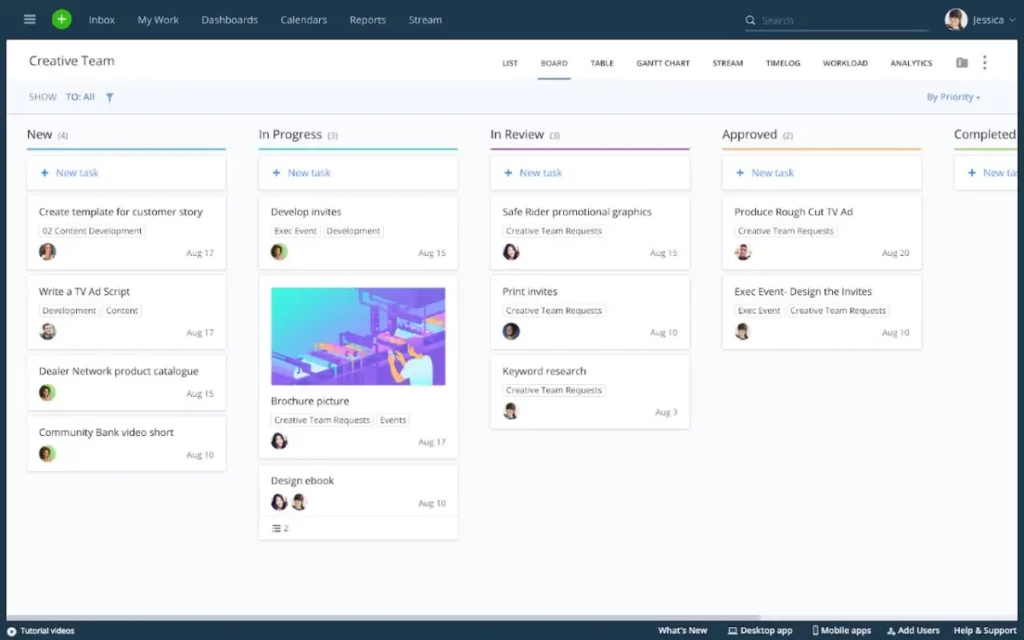
2. Filestage
Filestage is a dedicated online proofing tool designed to simplify the artwork approval process. It allows teams to upload, review, and annotate artwork files, enabling seamless collaboration and feedback collection.
Filestage’s user-friendly interface and efficient workflow management make it a popular choice for artwork approval across industries.
Pros
- Filestage specializes in providing robust proofing and review capabilities, allowing teams to annotate, comment, and collaborate on files in a streamlined manner
- It has an intuitive and user-friendly interface, making it easy for team members and clients to navigate and provide feedback on files without the need for extensive training
- Filestage allows users to set up customizable review workflows, including multiple stages, reviewers, and deadlines, ensuring a structured and organized approval process
- The software offers version control features, enabling teams to track changes and revisions made to files.
- Filestage integrates with popular file storage platforms like Google Drive, Dropbox, and Adobe Creative Cloud, facilitating seamless file sharing and collaboration.
Cons
- No mobile app available
Use case
Filestage is primarily used as an online proofing and review tool in various industries, especially in creative and marketing teams. Its main use case is to streamline the approval process for files, including designs, artwork, documents, videos, and other visual content.
Filestage helps teams gather feedback, iterate on revisions, and obtain approvals efficiently. It’s particularly beneficial for teams that heavily rely on collaboration, feedback collection, and revision cycles, such as creative agencies, marketing departments, and content creation teams.
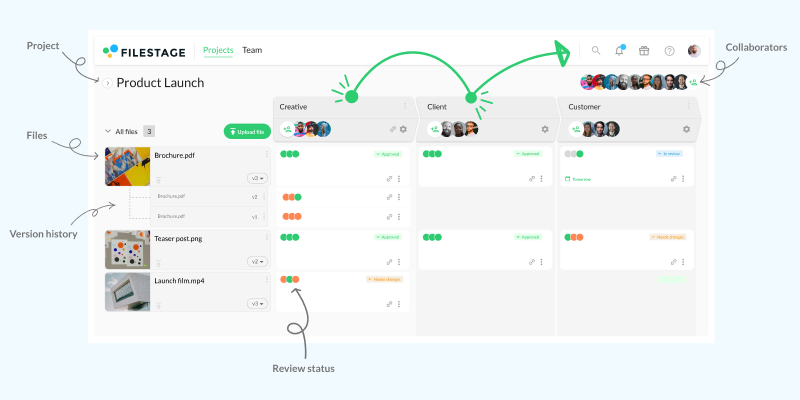
3. ProofHub
ProofHub is a versatile project management and collaboration tool that includes artwork approval features. It offers annotation tools, file sharing, document proofing, and review capabilities.
With ProofHub, teams can collaborate, track changes, and obtain approvals efficiently, ensuring smoother artwork approval management.
Pros
- ProofHub offers a wide range of project management features
- The software provides a centralized platform for team collaboration, offering features like discussions, file sharing, and real-time chat, promoting efficient communication, and teamwork
- ProofHub has an intuitive and user-friendly interface, making it easy for team members to navigate and adopt the software quickly
- It offers robust proofing and review capabilities, allowing teams to annotate, comment, and provide feedback on files, streamlining the approval process for artwork, documents, and designs
- The tool allows you to customize workflows, templates, and project settings to align with specific requirements
Cons
- Limited customization options compared to other project management tools
- Advanced reporting limitations
- Though ProofHub has a mobile app, users have reported occasional performance issues and limitations in terms of features compared to the web version
- Some advanced features in ProofHub require a learning curve
- Pricing is high compared to other project management tools.
Use case
ProofHub is well-suited for teams that require a comprehensive set of project management features, including task management, document sharing, and proofing capabilities.
Whether it’s managing marketing campaigns, software development projects, or creative tasks, ProofHub provides a centralized platform for your team to plan, communicate, and track progress.
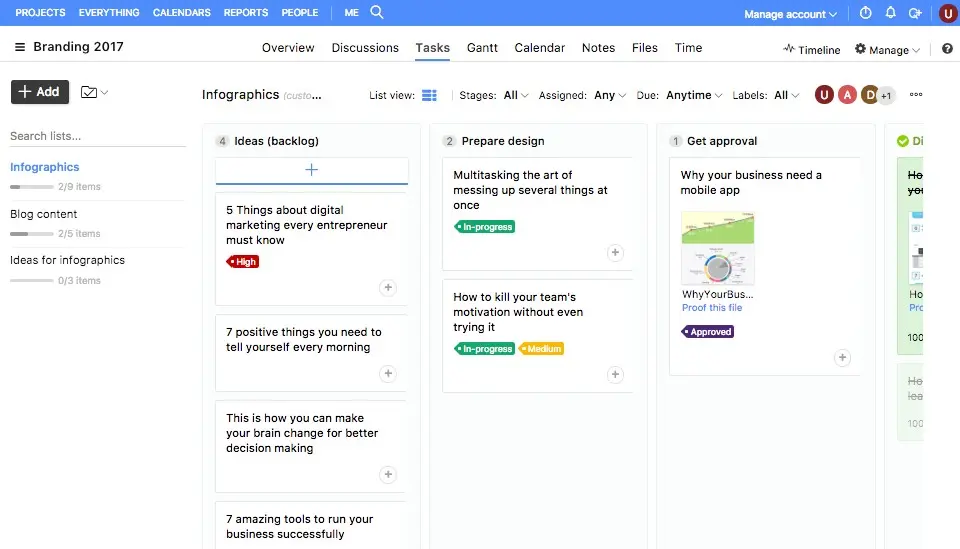
4. Workfront
Workfront is a powerful work management software that supports creative collaboration through powerful project management features. The tool is known for its scalability and ability to handle complex artwork project management requirements in large organizations.
Pros
- Workfront offers a wide range of features for managing work, including task management, resource allocation, project planning, and reporting, allowing teams to effectively plan, track, and execute projects
- It provides flexible customization options, allowing users to create workflows and project templates that align with their specific processes and requirements
- Workfront provides robust reporting and analytics capabilities
- It integrates with a wide range of third-party applications, like document management systems, collaboration tools, and customer relationship management (CRM) platforms
Cons
- Workfront’s comprehensive functionality may feel overwhelming for small, straightforward projects that don’t require extensive project management capabilities
- Implementing Workfront and training team members on its functionalities requires time and effort, especially for larger teams or organizations.
Use case
Workfront is particularly suitable for teams that require comprehensive project planning, resource management, and reporting capabilities.
Whether it’s managing marketing campaigns, product development, or complex projects with multiple stakeholders, the platform helps teams to collaborate, track progress, and optimize resources.

The future of artwork approval management
Artwork management is an essential aspect of corporate brand identity and regulatory compliance, and can expect significant advancements in the coming years. As technology continues to evolve, businesses need to stay ahead of the curve to effectively manage packaging artwork.
Here are some predicted trends and advancements in artwork approval management, along with strategies for businesses to stay proactive in this rapidly changing landscape.
- Automation and AI – The integration of automation and artificial intelligence (AI) will revolutionize artwork approval management. AI-powered tools can streamline processes like proofing, quality assurance, and artwork generation. This can help businesses automate repetitive tasks, reduce errors, and increase efficiency.
- Digital asset management – The shift towards digital assets will continue to gain momentum. Cloud-based digital asset management (DAM) systems will help businesses to store, organize, and access artwork assets securely. Implementing a robust DAM solution will facilitate efficient collaboration, version control, and retrieval of artwork files.
- Augmented reality (AR) – AR technology will play a significant role in the future of artwork approval. Businesses can leverage AR to visualize packaging process and design in real-world environments, allowing for better evaluation and testing. By embracing AR tools, companies can enhance the consumer experience and gather valuable insights into the impact of their artwork.
- Blockchain for transparency – Blockchain technology offers the potential for enhanced transparency and traceability in artwork approval management. By leveraging blockchain, businesses can track the journey of artwork from creation to release, ensuring authenticity, and minimizing the risk of counterfeiting.
How to navigate the latest trends in artwork approval management
To stay ahead of the curve in managing packaging artwork, you and your team should:
- Embrace technology by adopting emerging technologies, such as AI, automation, and AR, to optimize processes and increase efficiency.
- Implementing robust digital asset management systems and cloud-based platforms will allow your team to seamlessly collaborate and secure storage of artwork assets.
- Keep up with industry trends and evolving regulations to make sure you’ve incorporated the best practices into your artwork approval workflows.
- Encourage cross-functional collaboration between marketing, design, regulatory, and production teams to streamline the artwork approval process and minimize delays.
- Regularly assess and refine artwork approval management processes, leveraging data and feedback to drive continuous improvement.
Navigating artwork approval management
Successful artwork approval management will help your team create better projects and make sure you deliver them in time. And with the help of a dedicated artwork approval platform, you’ll have a central location for all your stakeholders and projects.
If you’d like to see how Filestage can help you navigate artwork approval management more efficiently, make sure to try it for free →


